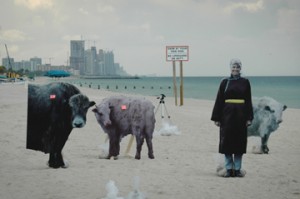« Editor's Picks
(re-) Creating History

Allard van Hoorn. Untitled (Productions images of Documentary (re-) Creating History), 2007. Digital photo. Courtesy Lili(ana)
This project is all about the paradox of history, the encounter and tourism. When I traveled to the outskirts of Mongolia to discover those who had never been in contact with the outside world I was hoping for authenticity, the ‘real’. Now, I realize that by succeeding in finding I instantly destroyed what I was looking for. This project is the re-enactment of these scenes set on the border with Kazakhstan 11 years ago.
The way this project reflects on Miami has to do with the way history is built up in the most prominent Latin part of the United States. The influx of many different cultures that formed their recent history since arriving here and the way these identities have developed after coming to a different country with different values in a different society. Re-staging the scenes out of the Mongolian isolation here in Miami is a way for me to research how these cultures are maintained under strong displaced circumstances. Is it possible to continue the traditions and rituals when you are forced to blend in when arriving in a new motherland? What do you have to do to be able to adapt to the new morals and ethics and live with them in harmony?
By restaging on Miami’s Surfside beach this project researches the way history is constructed and is being created. It examines how multiculturalism functions in Miami and how identity, ethnicity and history itself are developed, transformed and maintained through relocation and integration. The production and registration of the enactment was established by a diverse group of people related to Miami, who performed as concept consultants, stage builders, directors and documentalists and therefore became the active (re-) creators of history.
It all started out as a search for something that was untouched, uninfluenced by media, or TV or peer pressure or anything else. I was looking for people in their natural habitat, a thing in itself indefinable. I visited the Papua in Irian Jaya, who were still living in the Stone Age just decades ago when discovered by an airplane flying over the valley where they lived in a completely cut-off community of 200,000 people. Interesting things happened there.
I remember how we landed in a little village high in the mountains on an upward sloping landing strip where the catholic mission’s six-seater had to turn into sharply to come to a quick stop. We were greeted by what seemed to be the whole village dressed in nothing but straw miniskirts for women and penis guards made out of long orange calabash for men. Later we were told these villagers ate the missionary and his 11 helpers from Java one day in the late seventies when they got fed up. We walked around the little place, kids measuring the thickness of our thighs, being impressed.
The people traded pigs and bags as money and one day I showed a woman how to knit the braided fibers they otherwise knot together in an elaborate and time-consuming process. Only after moving on the other day, I realized this might have had a bigger influence on their culture and economy than I had assumed earlier. As a result it dawned on me that there is this strange relationship between the authentic and encountering the authentic. To find and know the untouched is a paradox because you will always be the first tourist to make an impact, to influence, immediately upon contact. You break the rule of the uninfluenced and the process is irreversible. Your traces on the encountered cannot be erased. Your traces are there for good. And therefore you cannot reach the authentic. You cannot determine it or understand it, because when you arrive the system is already changed.
All of this I have realized only recently while coming across my slides from these voyages to the Baliem Valley in Irian Jaya, the Lower Omo Valley in Ethiopia and the border between Mongolia and Kazakhstan. And looking at that one slide, that image of my girlfriend posing between a few yaks and me standing next to her in the wedding dress of the “authentic” nomads whom we had finally discovered made me wonder. It suddenly struck me there was something wrong with the whole imagery.
The man who took the picture lived in a very remote region of the country and had never been in contact with anybody other than his own neighbors. He had no TV, radio, newspaper or magazines. No one from the outside world had ever passed by his Yurt, his nomadic mobile home. And no one had ever worn his wedding clothes. He considered us fellow nomads, different of course by language, attire and our soft unwrinkled faces. He and his wife dressed us up and there we stood, kind of proud of finally finding what we were looking for; uninfluenced cultural authenticity.
But what is authenticity? If our host had no references to my world and if he never saw a photo camera before, it must mean that we were the main attraction. The roles were reversed; we became his new reference. We became subject to their view instead of them being subjected to ours. The paradox of our search for the uninfluenced lies in the outcome, when we became authentic to the ones we encountered. We had a complete set of physical and behavioral features that were unknown to these nomadic Mongols. And by posing, being them and they looking at us in their wedding dresses, they can see a representation of themselves being framed by looking through the camera lens while taking the picture of us. Whatever happened by shooting that image, it seems that the photo this “authentic” man took of us ultimately made me look at history, the encounter and tourism in a permanently altered way.


































